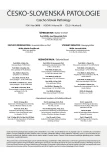Unusual lung finding of massive alveolar filling with foamy macrophages in congenital epidermolysis bullosa after amnion fluid aspiration in 15-day-old newborn without any clinical signs of respiratory impairment
Authors:
Daniel Farkaš 1; Marián Švajdler ml. 2; Lucia Fröhlichová 2; Jana Šprláková 3; Silvia Farkašová Iannaccone 4; Zoltán Szép 5; Oľga Nyitrayová 5
Authors‘ workplace:
Bioptická laboratoř s. r. o., Plzeň, Česká Republika
a Oddelenie patológie, Univerzitná nemocnica Louisa Pasteura, Košice, Slovenská Republika
; Úrad pre dohľad nad zdravotnou starostlivosťou, SLaPA pracovisko, Košice
1; Šiklův ústav patologie, Univerzita Karlova Praha, Lékařská fakulta Plzeň, Česká Republika
2; Detská fakultná nemocnica, Košice
3; Ústav súdneho lekárstva UPJŠ LF, Košice
4; Cytopathos s. r. o., Bratislava
5
Published in:
Čes.-slov. Patol., 51, 2015, No. 2, p. 89-93
Category:
Original Article
Overview
Epidermolysis bullosa represents a group of mechanobullous diseases which are most commonly genetically determined. We describe the case of a 15-day-old female newborn with congenital epidermolysis bullosa which was inflicted on aproximately 1/3 of her skin surface, who died because of incorrigible sepsis with multiorgan failure. The main topic of our report is a description of an unusual pulmonary finding of massive alveolar filling with foamy macrophages after amnion fluid aspiration, which contained a excessive amount of desquamated epidermal cells. Introduced case shows outstanding discrepancy of negative clinical finding on one side and massive histopathological finding on the other.
Keywords:
epidermolysis bullosa – foamy alveolar macrophages – amniotic fluid aspiration
Sources
1. Barnhill RL, Crowson AN, Magro CM, Piepkorn MW. Dermatopathology (3rd edn). The McGraw-Hill: New York; 2010: 324-327.
2. Fine JD. Inherited epidermolysis bullosa: recent basic and clinical advances. Curr Opin Pediatr 2010; 22(4): 453-458.
3. Fine JD, Hintner H. Life with Epidermolysis Bullosa (EB): Etiology, Diagnosis, Multidisciplinary Care and Therapy, Springer: Wien New York; 2009: 27.
4. Horn HM, Tidman MJ. The clinical spectrum of epidermolysis bullosa simplex. Br J Dermatol 2000; 142: 468-472.
5. Smith LT. Ultrastructural findings in epidermolysis bullosa. Arch Dermatol 1993; 129: 1578-1584.
6. Dettmeyer RB. Forensic Histopathology. Springer: Berlin Heidelberg; 2011: 218-219.
7. Fracasso T, Karger B, Vennemann M, Bajanowski T, Golla-Schindler UM, Pfeiffer H. Amniotic fluid aspiration in cases of SIDS. Int J Legal Med 2010; 124 (2): 113-117.
8. Leslie KO. My approach to interstitial lung disease using clinical, radiological and histopathological patterns. J Clin Pathol 2009; 62(5): 387-401.
9. Doeker B, Hussein A, Trowitzsch E. Interstitial lung diseases with pulmonary hypertension associated with epidermolysis bullosa in an infant. Klin Pädiatr 1998; 210(5): 340-344.
10. Dishop MK. Diagnostic pathology of diffuse lung disease in children. Pediatr Allergy Immunol Pulmonol 2010; 23(1): 69-85.
11. Smith LT, Miller AW, Kirz DA, Elias S, Brumbaugh S, Holbrook KA. Separation of noncutaneous epithelia in a fetus diagnosed in utero with junctional epidermolysis bullosa. Pediatr Res 1992; 31(6): 561-566.
12. Genest DR, Williams MA, Greene MF. Estimating the time of death in stillborn fetuses: I. Histologic evaluation of fetal organs; and autopsy study of 150 stillborns. Obstet Gynecol 1992; 80: 575-584.
13. Genest DR, Singer DB. Estimating the time of death in stillborn fetuses: III. External fetal examination; a study of 86 stillborns. Obstet Gynecol 1992; 80: 593-600.
Labels
Anatomical pathology Forensic medical examiner ToxicologyArticle was published in
Czecho-Slovak Pathology

2015 Issue 2
Most read in this issue
- Practical comments on examination of placenta in the second and third trimester of gravidity
- Molecular pathology of endometrial carcinoma – a review
- Unusual lung finding of massive alveolar filling with foamy macrophages in congenital epidermolysis bullosa after amnion fluid aspiration in 15-day-old newborn without any clinical signs of respiratory impairment
- EGFR in triple negative breast carcinoma: significance of protein expression and high gene copy number
